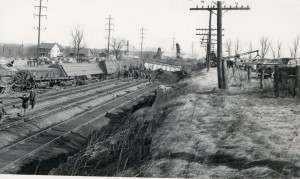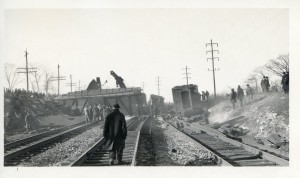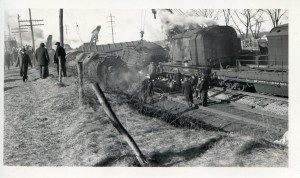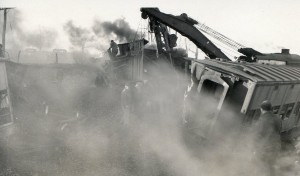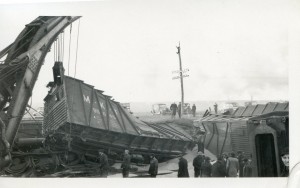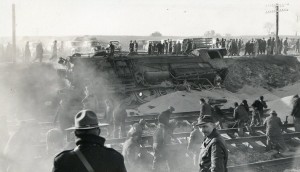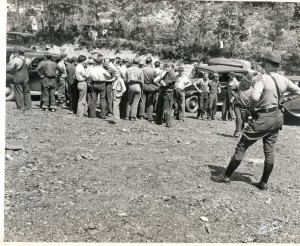 Twenty seven years old, only three years into his career, my father and one other Trooper drove into the aftermath of shootings and surging, furious crowds and a deep, complex, violent labor history. This is the lead of the news story that describes the day:
Twenty seven years old, only three years into his career, my father and one other Trooper drove into the aftermath of shootings and surging, furious crowds and a deep, complex, violent labor history. This is the lead of the news story that describes the day:
“Gunshot fire rang out, clubs were wielded and stones hurled in a violent clash between private detectives and bootleg miners at the scene of the new stripping operation of the Necho Coal Company near Donaldson this morning.” #
Miners and Officer at Donaldson: (my sister and I are convinced that the State Policeman pictured here is my father. His height seems right, the shape of the head and the haircut too, and he would sometimes stand in this manner.)
In July of 1941, deep in coal country northwest of Hamburg, north of Ravine and Echo Valley, west of Schuylkill Haven and Minersville, the Correale Coal Company brought in the Bucyrus, a name that sounds like a brutal creature from mythology and the largest strip mining shovel in the world, to begin a new operation near Donaldson. “Bootleg miners”, those miners who had begun their own independent operations on coal company land, feared that more shovels would arrive* and destroy their ability to survive by placing them at the mercy of the coal company:
“Yet, at the same time bootleggers saw this situation pragmatically: “We stole coal but …”; “We had no choice …”; “It was survival …”;”It was something we had to do …”; “There was no other way …”; “We had to feed our kids …”; “It was our bread and butter …”; “We had to take care of our families …” *
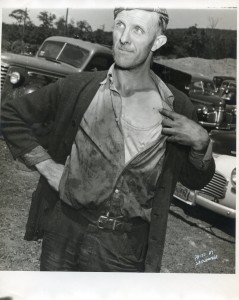 A Gun Shot Wounded Miner At Donaldson
A Gun Shot Wounded Miner At Donaldson
In 1934 Governor Gifford Pinchot refused to take the side of the coal companies in their dispute with the miners over bootlegging operations. He “suggested that the coal operators could put an end to the production of bootleg coal by reemploying the men ….” *
The coal regions of Pennsylvania had been centers of labor dispute for decades. Mines produced terrible injuries: “The conditions in the mines were horrendous and the men had to endure accidents, floods, fires and explosions. In one seven year period in Schuylkill County, 566 miners were killed and a further 1,665 were seriously injured. One of the worst disasters took place at Avondale colliery in 1869 when a fire killed 179 miners.”@ Such disasters, and the coal companies’ response, helped produce the Molly Maguires, a resistance organization of Irish miners that used murder and bombings in the 1870’s to try to achieve its aims.
The situation at Donaldson that morning was dangerous:
“Approximately 1500 miners and truckers from all parts of Schuylkill County collected at the west end of Donaldson in hundreds of trucks and cars and then several hundred marched up the steep road to … where the giant power shovel began operations yesterday morning. Women carrying babies in their arms… shouted encouragement to the men.” #
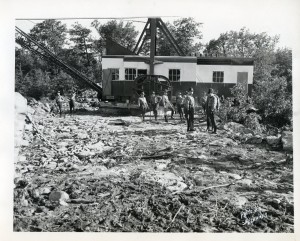 State Police On The Scene After The Shooting
State Police On The Scene After The Shooting
Private police hired by the coal company were waiting at the shovel. A miner interviewed by the reporter sets the scene:
The cops (operatives of the Gosselin [Detective] agency collected in a ring about the shovel as the men started to climb up the mountain road. They wanted to talk with the cops but when they got close, the cops started swinging their clubs. Then the fellows started to push in toward the shovel, but shots came from the shovel and the bootleggers ran back to cover in the bushes and behind the cars. Some of the fellows got shot in the back when they were running away. Then the shooting stopped and the men came out from cover. They had a meeting about 300 feet from the shovel.”#
Herbert Gosselin, in command of the private police offered this version of the events:
“A crowd estimated at 3500 to 4000 men came on the land and I told them they were trespassing on private property and we were paid to keep them off and we were going to do it. I walked back to the other officers and the crowd started to mutter and stones began to fly. A shot was fired from a shot gun. I don’t know who fired it but I think it was one of our men. Then everything was in a state of riot.”#
“Gosselin said there were four shots fired, three from shot guns and a revolver shot which he fired. At least seven were struck by pellets. Gosselin suffered a possible fracture of the right leg and body bruises when he was struck by flying stones. He said that when he was struck, the air was filled with a cloud of stones.” # He said, “I think I stopped part of the cloud.” #
My father and Trooper Dunleavy, both privates, “were patrolling the highway at Donaldson” when hundreds of bootleggers, “a few minutes after the shooting … appealed to [them] for protection, asking the officers to go up to the shovel and bring the [private cops] down so there would be no further trouble.” # In his testimony to a State Senate Committee investigating the disturbance, my father spoke of passing 150 trucks on State Highway 125 and then meeting a crowd of 3000 men, women and children. He and Dunleavy called the Pottsville Substation for reinforcements but then entered the crowd alone.
They were confronted by angry miners, and saw five of the wounded men; they knew that they were on their own for some time**, and had just been made the objects of an appeal to restore order. They had not witnessed the confrontation. They probably had all kinds of contradictory stories told to them. They had been called into the middle of a maelstrom; I cannot get out of my head that my father was only 27.
They had some advantages – the miners had already sought out their authority, and thus they had some time to act, not much probably, but a large enough window to calm the situation and prevent more bloodshed if they acted wisely. The miners obviously had drawn a distinction between the gun thugs of the coal company and the State Police. My father had to be thinking something like this — how do we calm such a crowd and ensure that it does not turn against us? The wrong word, the wrong posture or bearing, the wrong action and this very fluid, precarious situation could engulf both of them. How to give a sense to the miners that at least the first step toward justice had been taken and that their implied confidence in the fairness of the State Police had been justified?
Circumstances shifted and the violence suddenly promised to grow far worse. The private police, 25 of them, started down from the shovel and toward my father and Dunleavy. “They were halted about 200 feet from the highway by the parked cars of the bootleggers.” As they “attempted to run from the scene, they were manhandled by the crowd. The two … policeman intervened and rescued [them] by placing them under arrest and disarming them.”# This is the line that stopped me when I first read the story: “Heroic work by … Wall and Dunleavy was credited with saving the [private police] from more serious injury at the hands of the bootleggers….” #
To think of one’s father as acting heroically may be common in every child’s imaginings, but to read a stranger’s description of the actions that prompted the reporter’s use of the word “heroic” more than 70 years later creates a confusing welter of emotions – some stunned mixture of pride and sadness. I see him and Dunleavy in the middle of a huge crowd, themselves composed and cool, their bearing giving confidence to the miners that they could control the course of events, and then meeting the frightened private police, taking their weapons and arresting them and thus, at one stroke, sending ripples of calm through all those tight-bunched, desperate men. I wish he were here for us to tell him what we had discovered about his young manhood, that he had performed with “grace under pressure”@@ in very difficult circumstances, that his swift, smart decisions had prevented more bloodshed and brought honor to himself and to the State Police he so cherished, and that we also loved him for his humility, for he had never told us any of this story.
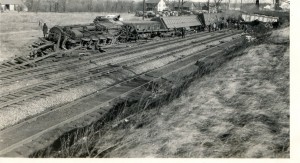 Turn the pages of The Book and years fly past in a few seconds, and now it is five years later, and my father has five more years of police experience, and now he moves from a two man patrol immersed in one fluid upheaval that could have exploded and into a disaster already consummated when he appears, one where he must operate as part of a vast team of men and women from multiple agencies all engaged in a rescue operation.
Turn the pages of The Book and years fly past in a few seconds, and now it is five years later, and my father has five more years of police experience, and now he moves from a two man patrol immersed in one fluid upheaval that could have exploded and into a disaster already consummated when he appears, one where he must operate as part of a vast team of men and women from multiple agencies all engaged in a rescue operation.
In January of 1946 a train filled with Mississippi and Louisiana veterans of Omaha Beach and The Bulge were riding in an “eight-coach troop train … bound for Camp Shelby, Mississippi … for discharge.”## It derailed a mile west of Myerstown ($). That shock would have been severe enough. To have survived D-Day and The Bulge and now be so close to home, finally safe, and then to be thrown out of the comforting rhythm of the ride, the coaches turning over, the frigid night wind filling the cars, smoke everywhere, darkness and confusion. But then, about two minutes later, “an eastbound 68-car freight train, heavily loaded, crashed into the … derailed coaches … the locomotives of both trains were hurled over on their sides, several troop coaches were jammed into the embankment and the train was … split open … by telescoped box-cars and gondolas which … folded up like an accordion after splitting wide open and scattering coal, corn and other content over the wreckage.”##
This becomes a story of resourcefulness and of a community’s response. “Word of the disaster reached nearby Myerstown quickly and scores of … townspeople rushed to the scene to lend assistance in caring for injured persons and aid in their removal from the wreckage. The sounding of sirens and bells was reported to have spread throughout … Myerstown.” ##
There is no clear indication as to when my father and other officers would have arrived. It would not have taken them very long — a train conductor “immediately left the train to spread the alarm…. Several telephones within a quarter-mile … were utilized and rescue efforts were started as soon as possible.” ## The article reports that he and 8 other State Police were there that night and into the next day to “perform various duties at the scene of the wreck, and furnish escorts for the ambulance runs in and out of the Gap reservation and [Lebanon].” ##
He would have seen a “dead soldier, half-buried in mud under the wreckage,” men suffering shock and the physically wounded enduring severe burns, fractures, and lacerations. He would have seen Red Cross men and women distributing coffee “to the soldiers huddled around bonfires they had built … for warmth along the railway tracks and around the field. Some wore bandages about their heads while others appeared to limp painfully around the upturned coaches seeking duffel bags [and] blankets which were … strewn near the shattered coaches.” He would have been assigned to help keep control of the “hundreds of autos and several thousand people [who] visited the wreck until early [the next] morning.” He would have heard the rumors, later disproved, of “several crushed bodies of soldiers … found under the overturned troop coaches.” He would have observed the swarms of Army brass and Railroad officials trying to make sense of what had happened. He would have watched the “four wreckers brought in” to move cars and engines. ## He would have watched daylight come and been amazed at the acres of twisted steel. I think he would have been in his element, alert to his duties, fully alive and engaged in the midst of chaos, and in his own small way making things right, assisting in the creation of order where something awful had occurred. I think he would have felt purposeful, a part of a big effort meant to ease panic and suffering. In every good way possible, I think he would have been very happy.
Clicking twice on any photo will enlarge and sharpen it.
#The newspaper’s name has been cut away. All quotations have been taken directly from the article.
*At least six more shovels were on their way. Michael Kozura, We Are All Leaders: The Alternative Unionism Of The 1930’s: page 222: online at: http://books.google.com/books?
* Kozura: page 208
http://www.spartacus.schoolnet.co.uk/USAmolly.htm @
*Kozura: page 217: How the coal companies gained control of so much land is a story for another to tell; the miners believed that the coal companies had stolen the land through corruption and force. The coal companies saw themselves as smart capitalists merely intent on modernizing their production, and that they had acquired the land they were stripping by lawful means. I know where my sympathies lie, but I am making an effort to just tell the story.
The three photos from Donaldson were found in The Book. The photos of the railroad accident were discovered in an envelope in another of my parents’ scrapbooks.
**They did not have two way radios.
@@Hemingway’s definition of courage and still the best one I think.
## From the Lebanon Daily News, January 19, 1946
($) I believe the location of the wreck was within a mile of the home we later rented on old Route 422 for the first 9 years of my childhood.
